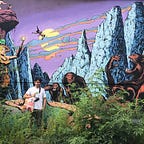Ride Lonesome (1959) — The Magnificent Twenty #20
Budd Boetticher’s Ride Lonesome comes in at number twenty on the list. The film was released in 1959, as loosely the fourth film in what’s known as the ‘Ranown Cycle’ of Westerns; it being another collaboration between Boetticher and writer Burt Kennedy, and acting as a starring vehicle for the then 61 year-old Randolph Scott.
Ride Lonesome follows Scott, as a typically stoic but seemingly troubled bounty hunter, known as Ben Brigade. Brigade sets out to bring in a cowardly young killer, Billy John, facing charges for murder in Santa Cruz. As Brigade sets out with Billy en route into town, they encounter Boone and Whit, an outlaw duo and acquaintances of Brigade. Karen Steele’s Mrs. Carrie Lane, an abandoned station master’s wife, also joins the men at this point. The tension among this group comes from the opportunity which Billy’s bounty represents. To Brigade, it’s just another job and a way for him to earn a living. To Boone and Whit, Billy’s successful deliverance to the sheriff could afford them a whole new life, with the promise of amnesty in place of the money. And, to Mrs. Lane, this group represents security in the wake of her husband’s disappearance and as the target of a group of Mescalero Indians who want to kidnap her.
What makes Ride Lonesome stand out to me is it’s clear subversion of any traditional bounty hunter narrative, choosing to have Billy found by Brigade, with apparent ease, at the very beginning of the film. Instead of seeing the heroes track Billy from Santa Cruz into the desert, the drama comes from the process of getting him back to civilisation in one piece. It leads to some really effective tension, and essentially gives Scott his own Unforgiven moment, as more of an exploration of the morals surrounding his career, as opposed to an adventure just demonstrating that. The image of the hanging tree is particularly striking, not only being a really great set piece for a sequence towards the end involving the great Lee Van Cleef in a brief role as Billy’s notorious older brother, Frank, but also as a manifestation of Brigade’s tattered conscience; an acknowledgement of a lifetime of regret assumedly towards the end of his life. This ending seems to be a common trait of Western myth, and I’m excited to see the different ways in which the other films on the list approach the idea.
Boetticher presents a West that’s full of treachery, but also one that’s not without honour and warmth. Boone and Whit represent a younger generation of outlaw, likely being in a position that Brigade would have been some thirty years earlier. Without spoiling anything, Brigade is able to give them something that he ultimately could never afford to give himself. These two men act as the heart of the film for me, and Kennedy litters his screenplay with small details to illustrate their relationship, such as Whit holding the mirror as Boone shaves. It’ll be good to see James Coburn tackle different roles, further up the list.
I think that the character of Mrs. Lane suffers the most from the era and climate in which Ride Lonesome was made. Despite some attempts for her to act as the main challenger to Brigade’s ideas of right and wrong, she was never given any real closure or even a solid resolution. It’s a shame, as Boetticher and Kennedy definitely prove themselves to be capable of creating original and grounded characters throughout. It makes me wonder how female characters are used in the other Ranown works.
The film also looks great. The cinematographer, Charles Lawton Jr., really manages to bring life to an otherwise barren environment, and in no small part aided by his adoption of the Eastmancolor process. The opening scene is particularly great, with really tight whip pan’s and crash zooms. This nicely plays into the idea that we’re joining the story, at what would be the climax of any other film.
Ride Lonesome was a fitting start to the list. To me, it seems emblematic of what I’m expecting from Western films of this era, and seeing that it sits right at the bottom of the list, I’m all the more eager to watch the rest.
Watched on Plex
